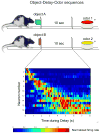Memory on time
- PMID: 23318095
- PMCID: PMC3558533
- DOI: 10.1016/j.tics.2012.12.007
Memory on time
Erratum in
- Trends Cogn Sci. 2013 May;17(5):255
Abstract
Considerable recent work has shown that the hippocampus is critical for remembering the order of events in distinct experiences, a defining feature of episodic memory. Correspondingly, hippocampal neuronal activity can 'replay' sequential events in memories and hippocampal neuronal ensembles represent a gradually changing temporal context signal. Most strikingly, single hippocampal neurons - called time cells - encode moments in temporally structured experiences much as the well-known place cells encode locations in spatially structured experiences. These observations bridge largely disconnected literatures on the role of the hippocampus in episodic memory and spatial mapping, and suggest that the fundamental function of the hippocampus is to establish spatio-temporal frameworks for organizing memories.
Copyright © 2012 Elsevier Ltd. All rights reserved.
Figures



Similar articles
-
On the Integration of Space, Time, and Memory.Neuron. 2017 Aug 30;95(5):1007-1018. doi: 10.1016/j.neuron.2017.06.036. Neuron. 2017. PMID: 28858612 Free PMC article. Review.
-
Time cells in the hippocampus: a new dimension for mapping memories.Nat Rev Neurosci. 2014 Nov;15(11):732-44. doi: 10.1038/nrn3827. Epub 2014 Oct 1. Nat Rev Neurosci. 2014. PMID: 25269553 Free PMC article. Review.
-
Human Hippocampal Neurons Track Moments in a Sequence of Events.J Neurosci. 2021 Aug 4;41(31):6714-6725. doi: 10.1523/JNEUROSCI.3157-20.2021. Epub 2021 Jun 28. J Neurosci. 2021. PMID: 34183446 Free PMC article.
-
Hippocampal place cells, context, and episodic memory.Hippocampus. 2006;16(9):716-29. doi: 10.1002/hipo.20208. Hippocampus. 2006. PMID: 16897724 Review.
-
The Generation of Time in the Hippocampal Memory System.Cell Rep. 2019 Aug 13;28(7):1649-1658.e6. doi: 10.1016/j.celrep.2019.07.042. Cell Rep. 2019. PMID: 31412236
Cited by
-
Re-expression of CA1 and entorhinal activity patterns preserves temporal context memory at long timescales.Nat Commun. 2023 Jul 19;14(1):4350. doi: 10.1038/s41467-023-40100-8. Nat Commun. 2023. PMID: 37468489 Free PMC article.
-
Predictable and unpredictable deviance detection in the human hippocampus and amygdala.Cereb Cortex. 2024 Jan 31;34(2):bhad532. doi: 10.1093/cercor/bhad532. Cereb Cortex. 2024. PMID: 38216528 Free PMC article.
-
Cortical and subcortical contributions to sequence retrieval: Schematic coding of temporal context in the neocortical recollection network.Neuroimage. 2015 Nov 1;121:78-90. doi: 10.1016/j.neuroimage.2015.07.040. Epub 2015 Jul 22. Neuroimage. 2015. PMID: 26209802 Free PMC article.
-
Mnemonic Content and Hippocampal Patterns Shape Judgments of Time.Psychol Sci. 2023 Feb;34(2):221-237. doi: 10.1177/09567976221129533. Epub 2022 Nov 28. Psychol Sci. 2023. PMID: 36442582 Free PMC article.
-
Interplay of hippocampus and prefrontal cortex in memory.Curr Biol. 2013 Sep 9;23(17):R764-73. doi: 10.1016/j.cub.2013.05.041. Curr Biol. 2013. PMID: 24028960 Free PMC article. Review.
References
-
- Aristotle (ca. 350 B.C.) On Memory and Reminiscence. In: Beare JI, translator; Ross WD, editor. The Works of Aristotle. Vol. 3. Clarendon Press; 1930.
-
- Tulving E. Précis of Elements of Episodic Memory. Behav Brain Sci. 1984;7:223–268.
-
- Vargha-Khadem F, et al. Differential effects of early hippocampal pathology on episodic and semantic memory. Science. 1997;277:376–380. - PubMed
-
- Shimamura AP. Memory for the temporal order of events in patients with frontal lobe lesions and amnesic patients. Neuropsychologia. 1990;28:803–813. - PubMed
Publication types
MeSH terms
Grants and funding
LinkOut - more resources
Full Text Sources
Other Literature Sources

